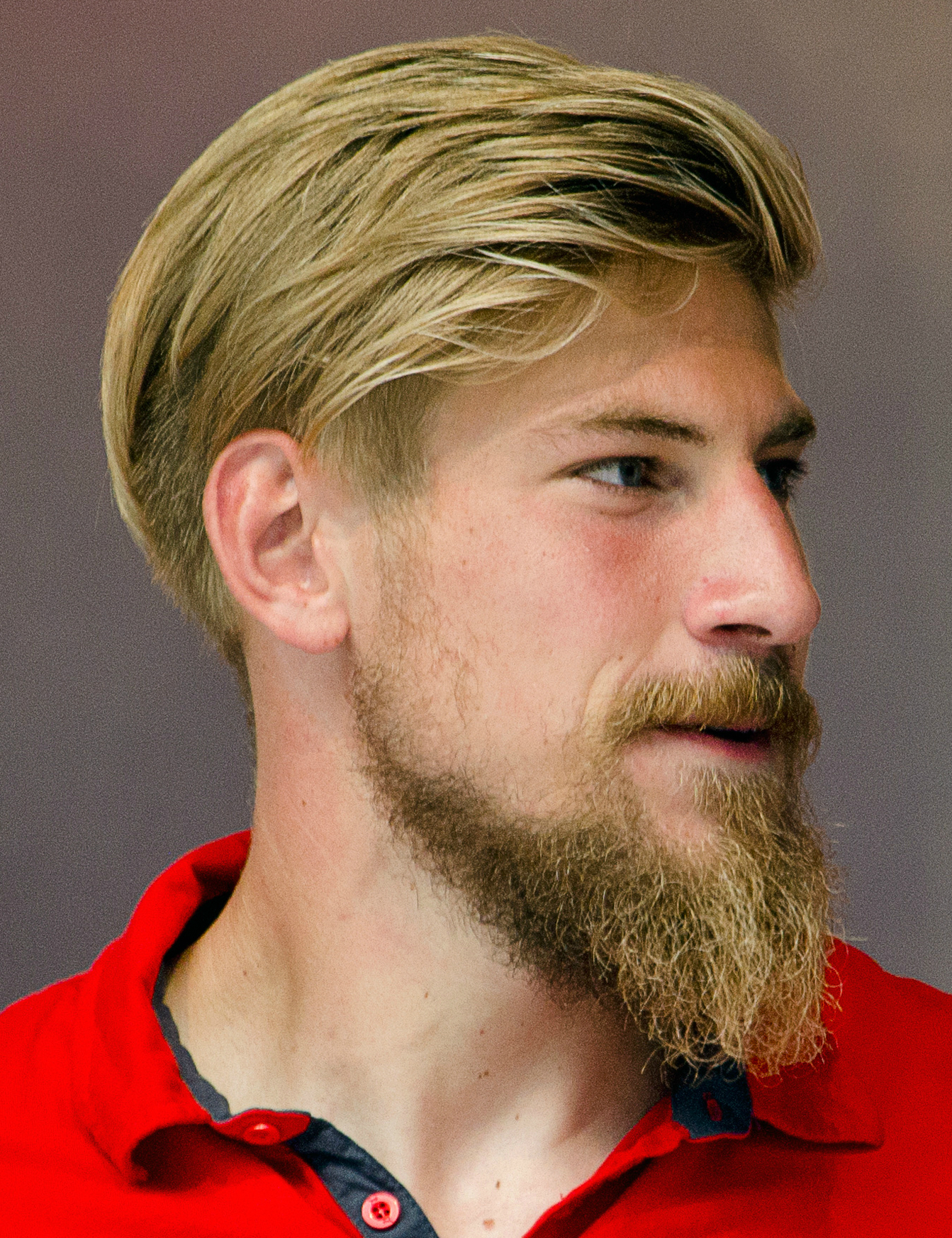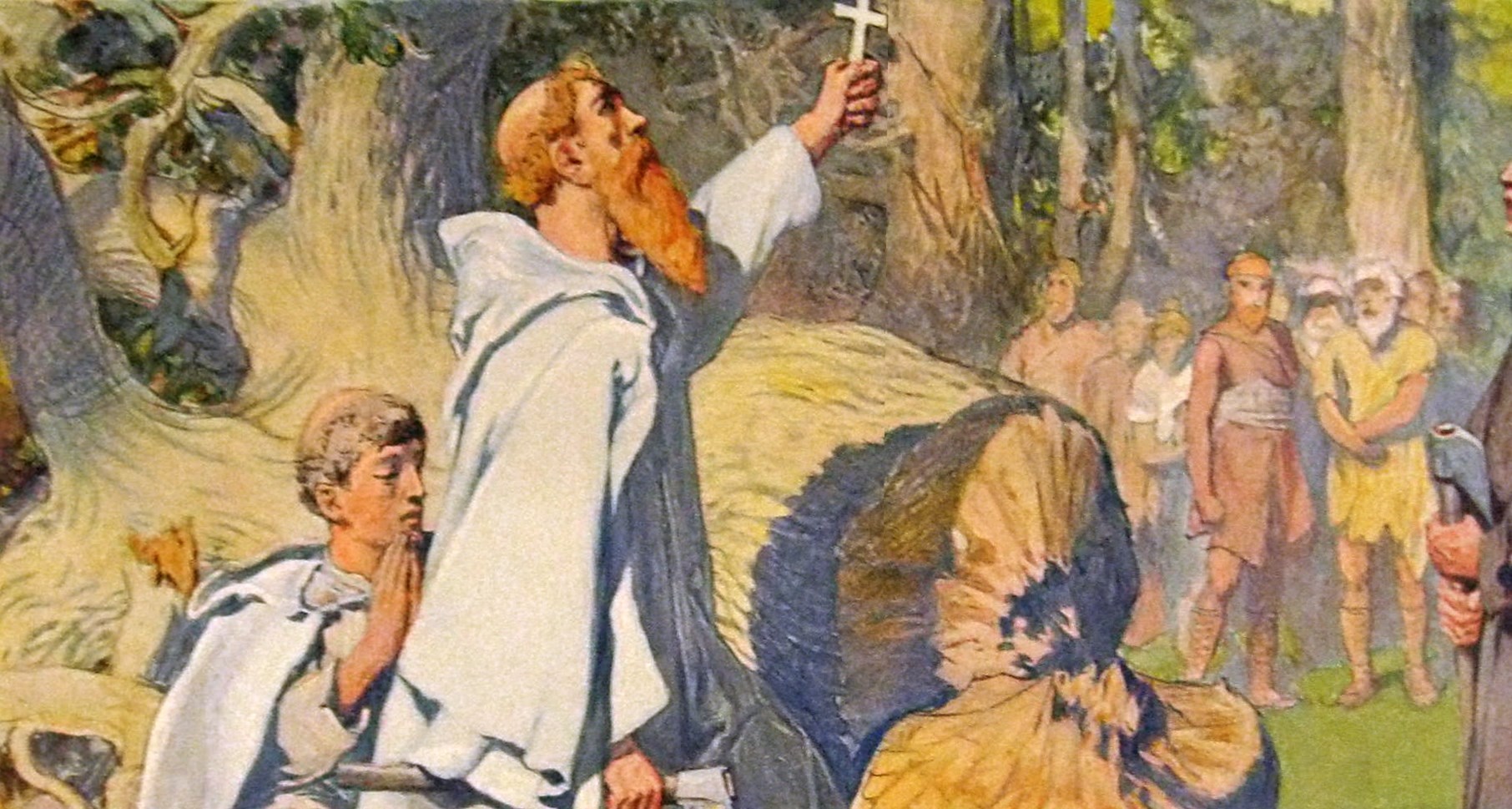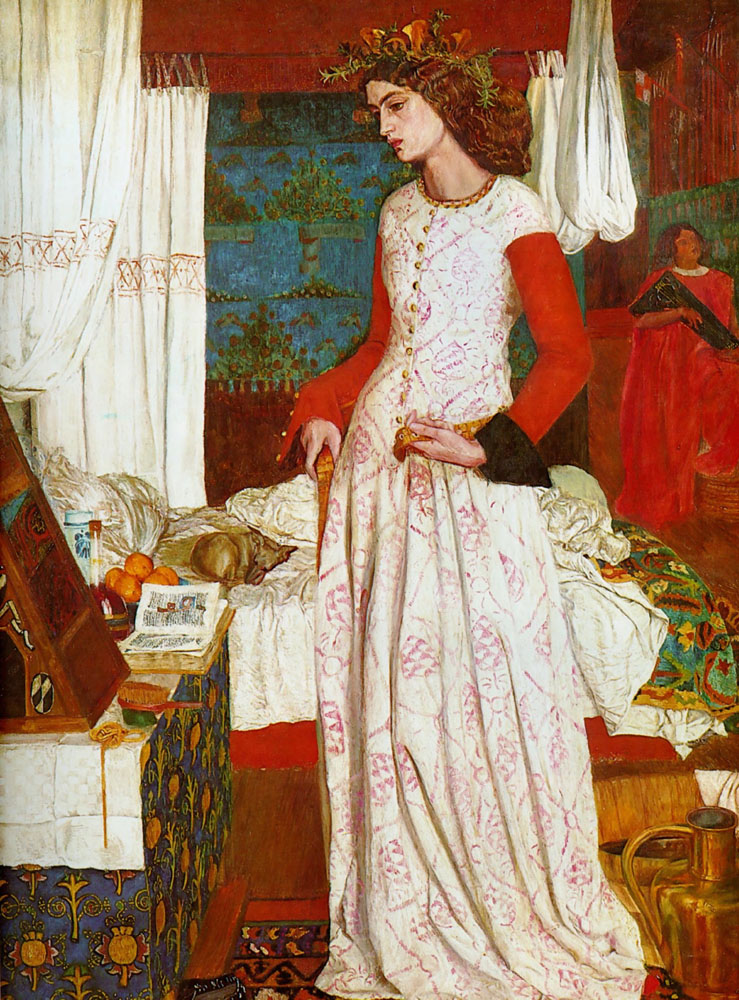|
Blonde
Blond () or blonde (), also referred to as fair hair, is a human hair color characterized by low levels of eumelanin, the dark pigment. The resultant visible hue depends on various factors, but always has some yellowish color. The color can be from the very pale blond (caused by a patchy, scarce distribution of pigment) to reddish "strawberry" blond or golden-brownish ("sandy") blond colors (the latter with more eumelanin). Occasionally, the state of being blond, and specifically the occurrence of blond traits in a predominantly dark or colored population are referred to as blondism. Because hair color tends to darken with age, natural blond hair is significantly less common in adulthood. Naturally-occurring blond hair is primarily found in people living in or descended from people who lived in Northern Europe, and may have evolved alongside the development of light skin that enables more efficient synthesis of vitamin D, due to northern Europe's lower levels of sunlight. Blond ... [...More Info...] [...Related Items...] OR: [Wikipedia] [Google] [Baidu] |
Blonde Stereotype
Blonde stereotypes are stereotypes of blonde-haired people. Sub-types of this stereotype include the " blonde bombshell" and the "dumb blonde". Blondes have historically been portrayed as physically attractive, though often perceived as less intelligent compared to their brunette counterparts. There are many blonde jokes made on these premises. However, research has shown that blonde women are not less intelligent than women with other hair colors.Jay L. Zagorsky"Are Blondes Really Dumb?" Economics Bulletin 36(1):401-410 · March 2016 In contemporary popular culture, it is often stereotyped that men find blonde women more Physical attractiveness, physically attractive than women with other hair colors.Victoria Sherrow. ''Encyclopedia of hair: a cultural history''Page 149/ref> For example, Anita Loos popularized this idea in her 1925 novel '' Gentlemen Prefer Blondes''. Blondes are often assumed to have more fun; for example, in a Clairol commercial for hair colorant, they us ... [...More Info...] [...Related Items...] OR: [Wikipedia] [Google] [Baidu] |
Chestnut Hair
Brown hair, also referred to as brunette (when female), is the second-most common human hair color, after black hair. It varies from light brown to dark hair. It is characterized by higher levels of the dark pigment eumelanin and lower levels of the pale pigment pheomelanin. Brown hair is common among populations in the Western world, especially among those from Northwestern Europe and the United States, as well as populations in Central Europe, Southeastern Europe, Eastern Europe, Southern Europe, Southern Cone, Brazil, Colombia, Costa Rica, Puerto Rico, and also some populations in the Middle East, Central Asia where it transitions smoothly into black hair.Frost, Peter"Why Do Europeans Have So Many Hair and Eye Colors?"(summarizing Frost, P. 2006. European hair and eye color - A case of frequency-dependent sexual selection? Evolution and Human Behavior 27:85-103) Additionally, brown hair is common among Australian Aboriginals and Melanesians. Etymology and grammar The term ... [...More Info...] [...Related Items...] OR: [Wikipedia] [Google] [Baidu] |
Human Hair Color
Human hair color is the pigmentation of human hair follicles and hair, shafts due to two types of melanin: eumelanin and pheomelanin. Generally, the more melanin present, the darker the hair. Its tone depends on the ratio of black or brown eumelanin to yellow or red pheomelanin. Melanin levels can vary over time, causing a person's hair color to change, and one person can have hair follicles of more than one color. Some hair colors are associated with some ethnic groups because of the observed higher frequency of particular hair colors within their geographical region, e.g. straight, dark hair amongst East Asians, Southeast Asians, Polynesians, some Central Asians, and Indigenous peoples of the Americas, Native Americans; a large variety of dark, fair, curly, straight, wavy or bushy amongst Europeans, West Asians, some Central Asians, and North Africans; and curly, dark, and uniquely helical hair amongst Sub Saharan Africans. Bright red hair is found in some European populations ... [...More Info...] [...Related Items...] OR: [Wikipedia] [Google] [Baidu] |
Eumelanin
Melanin (; ) is a family of biomolecules organized as oligomers or polymers, which among other functions provide the pigments of many organisms. Melanin pigments are produced in a specialized group of cells known as melanocytes. There are five basic types of melanin: eumelanin, pheomelanin, neuromelanin, allomelanin and pyomelanin. Melanin is produced through a multistage chemical process known as melanogenesis, where the oxidation of the amino acid tyrosine is followed by polymerization. Pheomelanin is a cysteinated form containing poly benzothiazine portions that are largely responsible for the red or yellow tint given to some skin or hair colors. Neuromelanin is found in the brain. Research has been undertaken to investigate its efficacy in treating neurodegenerative disorders such as Parkinson's. Allomelanin and pyomelanin are two types of nitrogen-free melanin. The phenotypic color variation observed in the epidermis and hair of mammals is primarily determine ... [...More Info...] [...Related Items...] OR: [Wikipedia] [Google] [Baidu] |
Thor
Thor (from ) is a prominent list of thunder gods, god in Germanic paganism. In Norse mythology, he is a hammer-wielding æsir, god associated with lightning, thunder, storms, sacred trees and groves in Germanic paganism and mythology, sacred groves and trees, Physical strength, strength, the protection of humankind, hallowing, and fertility. Besides Old Norse , the deity occurs in Old English as , in Old Frisian as ', in Old Saxon as ', and in Old High German as , all ultimately stemming from the Proto-Germanic theonym , meaning 'Thunder'. Thor is a prominently mentioned god throughout the recorded history of the Germanic peoples, from the Roman Empire, Roman occupation of regions of , to the Germanic expansions of the Migration Period, to his high popularity during the Viking Age, when, in the face of the process of the Christianization of Scandinavia, emblems of his hammer, , were worn and Norse paganism, Norse pagan personal names containing the name of the god bear witness ... [...More Info...] [...Related Items...] OR: [Wikipedia] [Google] [Baidu] |
Old English Language
Old English ( or , or ), or Anglo-Saxon, is the earliest recorded form of the English language, spoken in England and southern and eastern Scotland in the Early Middle Ages. It developed from the languages brought to Great Britain by Anglo-Saxon settlers in the mid-5th century, and the first Old English literature dates from the mid-7th century. After the Norman Conquest of 1066, English was replaced for several centuries by Anglo-Norman (a type of French) as the language of the upper classes. This is regarded as marking the end of the Old English era, since during the subsequent period the English language was heavily influenced by Anglo-Norman, developing into what is now known as Middle English in England and Early Scots in Scotland. Old English developed from a set of Anglo-Frisian or Ingvaeonic dialects originally spoken by Germanic tribes traditionally known as the Angles, Saxons and Jutes. As the Germanic settlers became dominant in England, their language re ... [...More Info...] [...Related Items...] OR: [Wikipedia] [Google] [Baidu] |
Old French
Old French (, , ; ) was the language spoken in most of the northern half of France approximately between the late 8th [2-4; we might wonder whether there's a point at which it's appropriate to talk of the beginnings of French, that is, when it was deemed no longer make to think of the varieties spoken in Gaul as Latin. Although a precise date can't be given, there is a general consensus (see Wright 1982, 1991, Lodge 1993) that an awareness of a vernacular, distinct from Latin, emerged at the end of the eighth century.] and mid-14th centuries. Rather than a unified Dialect#Dialect or language, language, Old French was a Dialect cluster, group of Romance languages, Romance dialects, Mutual intelligibility, mutually intelligible yet Dialect continuum, diverse. These dialects came to be collectively known as the , contrasting with the , the emerging Occitano-Romance languages of Occitania, now the south of France. The mid-14th century witnessed the emergence of Middle French, the lang ... [...More Info...] [...Related Items...] OR: [Wikipedia] [Google] [Baidu] |
Anonymous Ferdinand Of Austria In Hungarian Costume (detail)
Anonymous may refer to: * Anonymity, the state of an individual's identity, or personally identifiable information, being publicly unknown ** Anonymous work, a work of art or literature that has an unnamed or unknown creator or author * Anonymity (social choice), a property of a voting rule, saying that it does not discriminate apriori between voters Organizations * Anonymous (hacker group), the collective name of loosely affiliated individuals who participate in hacktivism Film and television * "Anonymous" (''Australian Playhouse''), an Australian television play * ''Anonymous'' (film), a 2011 film * ''Anonymous'' (TV series), a 2006 Irish television show * "Anonymous" (''CSI''), a 2000 episode of ''CSI: Crime Scene Investigation'' * "Anonymous" (''NCIS: Los Angeles''), a 2010 episode of ''NCIS: Los Angeles'' Music * Anonymous (band), an Andorran band * ''Anonymous'' (Blackbear album) (2019) * ''Anonymous'' (Stray from the Path album) (2013) * ''Anonymous' ... [...More Info...] [...Related Items...] OR: [Wikipedia] [Google] [Baidu] |
Iseult
Iseult ( ), alternatively Isolde ( ) and other spellings, is the name of several characters in the legend of Tristan and Iseult. The most prominent is Iseult the Blonde, or Iseult of Ireland, the wife of Mark of Cornwall and the lover of Tristan. Her mother, the queen of Ireland, is also named Iseult. The third is Iseult of the White Hands, or Iseult of Brittany, the daughter of Hoel and the sister of Kahedin. Name Her name is variably given as most commonly either Iseult or Isolde, but also may appear as Yseult, Ysolt, Isolt, Isode, Isoude, Iseut, Isaut (Old French), Iosóid (Irish), Esyllt (Welsh), Ysella (Cornish), Isolda (Portuguese, Spanish), Izolda (Serbian) and Isotta (Italian), among other forms. The oldest source, Béroul's 12th-century romance, spells her name as ''Yseut'' or ''Iseut''. The etymology is uncertain, with most sources linking it to the Old High German words ''īs'' ("ice") and ''hiltja'' ("battle"). Other writers derive it from a Brythonic *''Adsilt ... [...More Info...] [...Related Items...] OR: [Wikipedia] [Google] [Baidu] |
Norse Mythology
Norse, Nordic, or Scandinavian mythology, is the body of myths belonging to the North Germanic peoples, stemming from Old Norse religion and continuing after the Christianization of Scandinavia as the Nordic folklore of the modern period. The North Germanic languages, northernmost extension of Germanic mythology and stemming from Proto-Germanic folklore, Norse mythology consists of tales of various deities, beings, and heroes derived from numerous sources from both before and after the pagan period, including medieval manuscripts, archaeological representations, and folk tradition. The source texts mention numerous gods such as the thunder-god Thor, the Huginn and Muninn, raven-flanked god Odin, the goddess Freyja, and List of Germanic deities, numerous other deities. Most of the surviving mythology centers on the plights of the gods and their interaction with several other beings, such as humanity and the jötnar, beings who may be friends, lovers, foes, or family members of ... [...More Info...] [...Related Items...] OR: [Wikipedia] [Google] [Baidu] |








